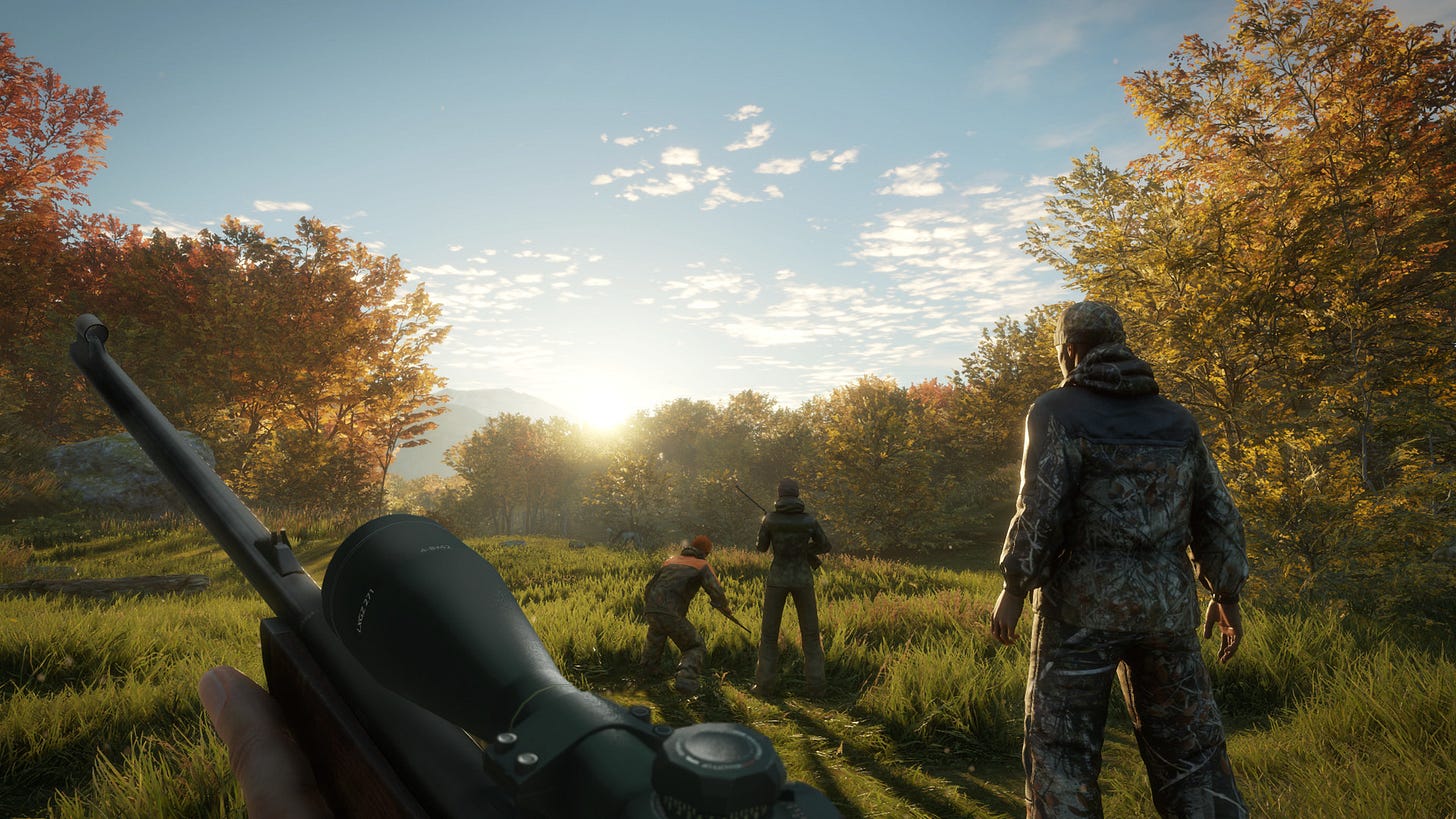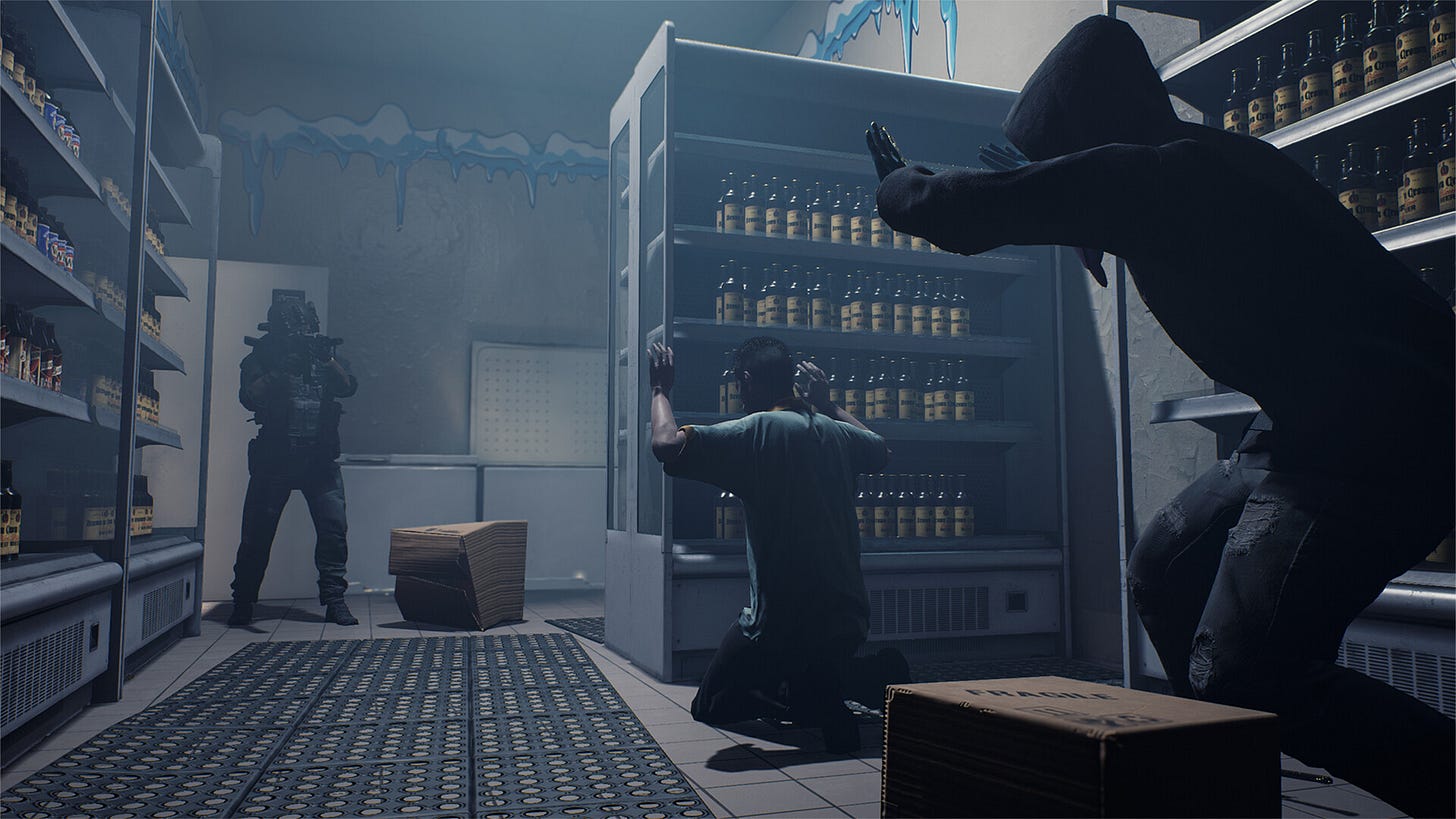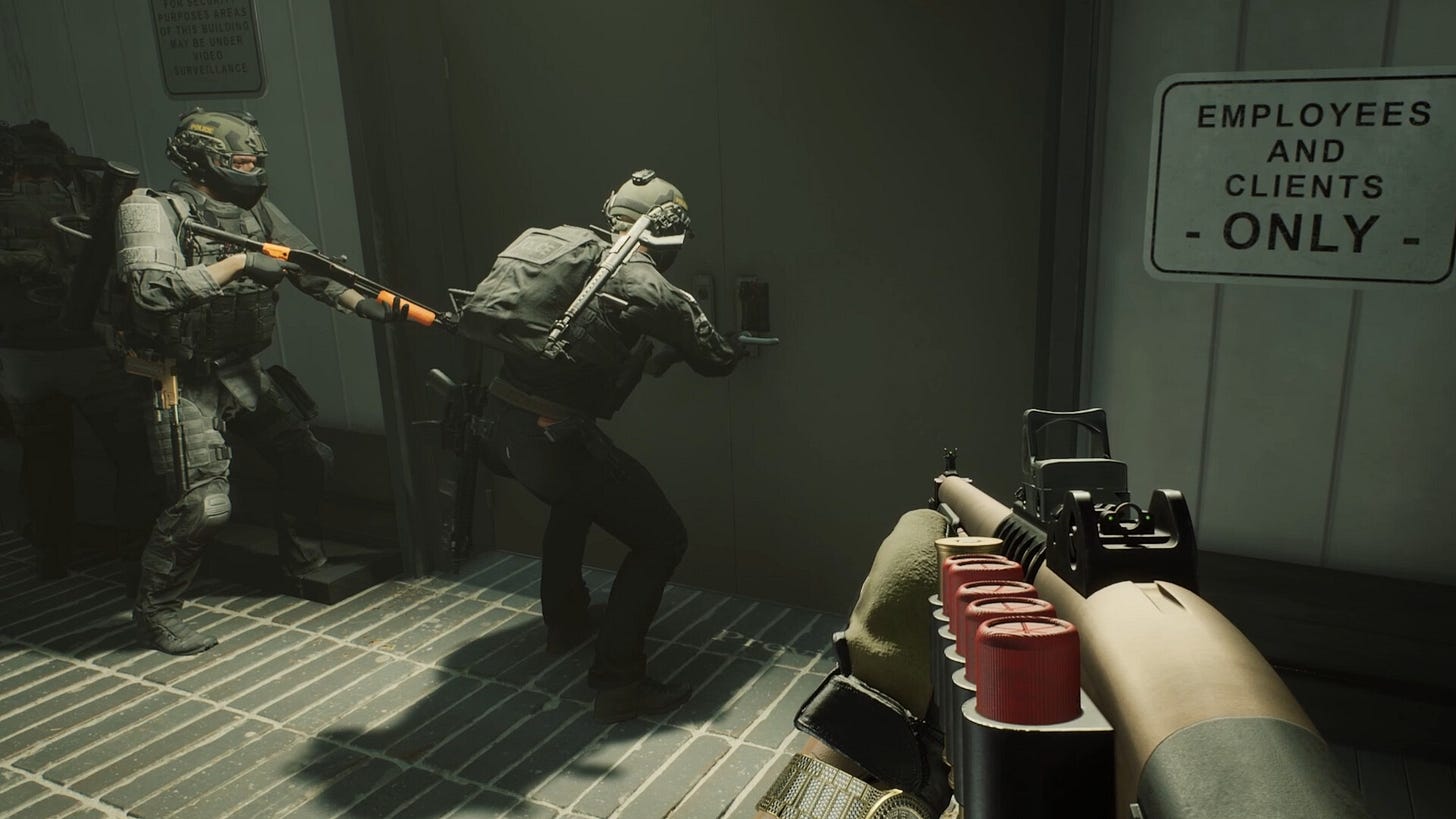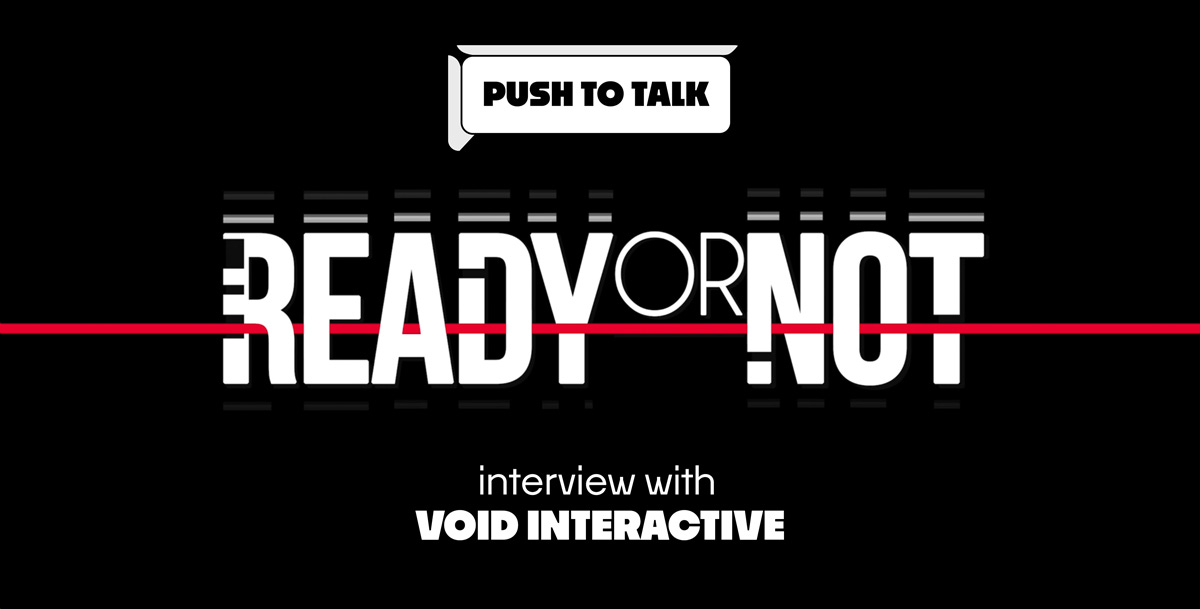The Unlikely Origins and Explosive Success of Ready or Not
push to talk #35 // an interview with the creators of ready or not

I started writing this newsletter partly because the games industry keeps surprising me, even 10 years after I started working in it.
One example: I keep finding PC games that have grossed tens of millions or even >100 million dollars, even though most people have never heard of them.
This shouldn’t really be possible. It’s too much money for an entertainment product to make while slipping under the radar. Such a thing could never happen for a novel. Certainly not for an album or a song. Hollywood offers the only real comp.
But even then, most movies that make nine figures are movies you’ve heard of.
$100 million is roughly what A24’s Civil War made in worldwide box office sales.1 Ryan Gosling’s hit The Fall Guy made about $93 million domestically.2
And yet… here are three under-discussed games that have likely3 grossed over $100 million on Steam alone:
theHunter: Call of the Wild (2017)
6,160,000 copies sold / $107,432,000 gross
This one’s a super serious and detailed hunting simulator. Sort of the ultimate “hunt from your couch” experience. It’s a big hit on consoles as well, and seems to do extremely well with DLC, so the figure above (which is Steam only) is a lowball estimate.
Squad (2015)
4,853,500 copies sold | $127,821,000 gross
100-player military shooty game. Seems to be addressing market demand that hasn’t been met by the Battlefield franchise in recent years.
Ready or Not (2021)
5,122,600 copies sold | $149,685,000 gross
This is the one I really want to talk about.
Ready or Not is a self-published, story-based, mostly single-player (and co-op) FPS that has defied all logic and become a perennial seller on Steam since it first appeared as an Early Access game in December 2021.
I recently wrote a post about how reviews-per-week charts reveal how some games can sell incredibly well for years on end. Ready or Not is one of those games:

At the low end, they look to be selling over 20,000 copies per week, at anywhere between $29.99 and $49.99 a pop. You can do the math. RON is a certified hit.
Recently I reached out to Ready or Not devs VOID Interactive to talk to them about the history of the game and the insane journey that saw a tiny dev team ship one of the biggest hit FPS games of the 2020s.
In the Q&A that follows lower in this article, I’m basically asking the VOID team about their go-to-market strategy and how they’ve built and maintained community around the game. It’s the kind of marketing-brained stuff you can expect from this newsletter.
But before we get into that, I wanna take a brief detour to address the elephant in the room, which is that Ready or Not is not a “feel-good” game.
You Might Not Be Ready
Ready or Not’s scenarios are extremely detailed simulations of things like hostage situations and mass shooting events. One level features a shooting at a community college.
Its own developers put a content warning on the game’s Steam page that says they “strongly recommend that people who have experienced personal traumatic events from criminal violence, hostage situations, or terrorism refrain from playing.”
Here’s the game’s launch trailer, to give you a sense of its tone:
Most coverage of Ready or Not from press and influencers uses the word “controversial” to describe the game, but many of those willing to give it a chance tend to come away feeling shaken but satisfied by the way it handles its scenarios. This is, after all, a first person shooter that rewards you for not killing anyone (getting an S rank on any given level requires zero casualties, either for your squad or for the hostiles).
A common theme in reactions to the game is that it seems to re-sensitize otherwise desensitized players to the horror of gun violence, something I’ve never seen said about an FPS game. So this ain’t exactly Grand Theft Auto.
But others come away with suspicions that the game’s politics are “unsavoury,” as a writer for PC Gamer put it, which is probably inevitable for a game where you play as the cops.
I lean toward a more generous interpretation of the game, but I don’t think the PC Gamer writer’s take is so easily dismissed, as Ready or Not’s horror-soaked missions often resist a clear moral takeaway or message. It’s a seriously gritty game, and even if—like me—you’d love to see games push into dangerous artistic territory typically reserved for film or literature, there remains something highly dissonant about being able to say “I got an S rank on the school shooting level.”
This perhaps explains why Ready or Not has never been formally reviewed by major video game media outlets like IGN, Polygon, Destructoid, GamesBeat, Screen Rant, GamesRadar, Edge, Wired, or Gamespot.4 When many games are explicitly designed to divert players’ attention from the real world, what are critics supposed to do with a game like this?
Before I reached out to VOID Interactive, I watched every video they’ve ever published about the game and read through every update they’ve posted to Steam. I read their developer AMAs on Reddit and interviews they’ve done with press. I did this because I wanted to get a better sense of how they think about the greater meaning of Ready or Not.
Overwhelmingly, the impression I got is that this team wants to make an experience that forces players to engage with a horrifying aspect of the real world—especially for people in the United States, where SWAT squads getting called in to deal with an active shooter has become an almost regular, recurring segment in the national news cycle. VOID seems intent on rendering that horror in a way that’s as faithful to reality as possible within the limits of game mechanics, and without disrespecting victims or glorifying violence. Even in the cases where it seemed like VOID devs were a little too eager to run toward controversy, it reads to me as a team excited to make something that pushes at the boundaries of what games are allowed to be.
That’s my take! Reasonable minds could disagree or find fault with VOID’s execution on this stuff. (And actually, I wish more critics would engage deeply with the game and offer up some different perspectives.)5 But I give VOID the benefit of the doubt, and personally find what they’re doing to be fascinating.
So I reached out to them, and asked about how the game came together.
The Players Were Ready
To pick a starting point for the Ready or Not story, you’d have to go back at least seven years, to May 2017, when the then-tiny VOID Interactive team released an early concept trailer for the game.
Stirling Rank, now the Chief Operations Officer at VOID, says there were only three or perhaps four people working at the company when the below trailer was released.
This was clearly an extremely polished pitch for a game that—at the time—was still in early development. Rank says that the trailer was made in just a few weeks, with a budget of at most a couple of hundred dollars, most of which was spent on a Perception Neuron motion capture system.
The response from players was immediate and overwhelming.
Players instantly grasped that Ready or Not was inspired by the Sierra Entertainment-published SWAT series—a series which has basically lain dormant since the release of SWAT 4 in 2005.
Or, more to the point:
“The trailer blew up, definitely to our surprise,” Rank says. “We were getting emails left and right from fans of the genre to publishers who wanted to have a chat with us. It was a pretty crazy time, especially when we had really only started. However, we were fully convinced we could do it in a reasonable amount of time, even with a small team…”
Of course, the team was still years away from delivering on the vision. But they’d gotten an enormous shot in the arm and a vote of confidence from players.
“Honestly when we released that trailer, we simply wanted to share our concept with the world,” Rank says. “It was a great way of letting folks know that there was a team out there attempting to create something that tactical FPS fans had been asking for, for almost 12 years at the time.”
Seven years later, VOID has over 30 full time staff, and continues to service Ready or Not with a mix of free updates and paid DLC expansion packs. The studio’s headquartered in Ireland, but studio reps say staff is spread across the world.
I think the Ready or Not story is ultimately about a team with a crystal-clear vision for what they wanted to make, and who they were making it for. They successfully delivered on that vision, and now they’re reaping the rewards.
But along the way, they also made some smart decisions that took this from being merely a hit game to something bigger: a perennial seller.
We dig into some of those decisions in the full Push to Talk Q&A with VOID Interactive’s Stirling Rank below:
PUSH TO TALK: Something that jumps out at me about the marketing for Ready or Not is how clean and focused its positioning is. The game's target audience seemed to understand instantly that it’s a spiritual successor to the SWAT series.
STIRLING RANK: There’s a clear benefit to being in a small echelon of tactical first-person shooters that frames gameplay around using tools and strategy before employing reasonable force. I think games within this genre, like Ready or Not, can become quickly recognizable due to the limited amount of similar shooters on the market, naturally.
At its core, while a big focus is to make every encounter with an individual a potentially dangerous one (something most shooters cannot achieve as they will hurl entire platoons at a single player to offer a basic challenge), we also mix this gamified take on policing with an embellished world, ripe with cultural commentary and reflection. We’re similarly poised to be able to explore a very dark narrative with confronting topics due to the theme and genre. None of this would be possible (including some of our marketing beats) without the games initial positioning.
As we continue to develop these mechanics and cover these themes across Ready or Not, I believe the franchise will continue to stand out within the tactical FPS genre.
PTT: Can you talk a bit about how the game was funded originally? I heard a really interesting story through the grapevine that VOID had a loyal patron that saw the studio through its early days.
STIRLING: That loyal patron is our CEO to this day, Julio Rodriguez. He saw the passion that we had as young developers and determined it was worth taking a risk to try something new.
He had already gained significant experience through his previous executive roles in different industries worldwide, so his business acumen allowed us to grow as leaders very quickly. If there was ever any “luck” (which is a word I don’t use often) with Ready or Not , it was running into Julio.
PTT: Can you break down for me the things that you felt were most effective at building community, especially leading up to that Early Access launch moment? I'm particularly interested in the efficacy of the alpha access pre-orders you guys were selling on your website, and how important that was to the strategy.
STIRLING: We entered into a pre-release funding period between that trailer and the 2021 release. But I don’t want to misrepresent it—it was a complicated time and was by no means a linear path from inception to Early Access.
Early on, the pre-orders we received allowed some players to have access and provide our team with feedback, and this helped a lot, but much of that very strong feedback went unaddressed due to our lack of experience. Regardless, those pre-orders allowed us to continue working on the game and building a community until its eventual public arrival.
A few years later, before we released to Early Access, we gave the Supporter Edition owners private access and made a number of key improvements to the game before we finally released it, all thanks to people who were playing it and giving us feedback in our time of need.
To say this game would not have existed without the community behind it is an understatement, and I feel that way even more so now with the growing modding base of Ready or Not.
PTT: Many of the pre-release newsletters you shared with players focused on issues the most hardcore players would care about, like weapon audio, as one example. How impactful is that sort of behind-the-scenes content for you guys, and what specifically do you hope to see players take away from it?
STIRLING: Behind the scenes content was really important early on as our game was actively in early development. Any improvement we made to the game we wanted to share with our community. It was often a point of pride, being able to showcase some new discovery or cool feature, something for readers to share excitement in. We carry this mentality forward today, although it is more sparing as many of our advancements are under the hood, and less player facing. But you’ll often see the audio team sharing some cool details about a new feature of the game’s sound, for example.
While some of the behind-the-scenes content has changed over the years, appealing to the hardcore gaming community with the community newsletter was and is an important step towards continuing to build and establish the fanbase with Ready or Not ever since the debut of our reveal trailer.
PTT: Probably the most surprising thing about Ready or Not's success is that it's primarily single-player/co-op, whereas common games industry wisdom says PVP is the only way to succeed as an FPS. How does your team think about content strategy for ongoing releases for a game like this?
STIRLING: Games industry wisdom is short-sighted. In other words, it’s not so wise. In some ways Ready or Not is a spiritual successor to older games in general: it respects the player and understands that in order for a game to last for a long time, it must be propagated by the community. For that to happen two key things must exist: the game needs to be fun, and it needs to support a community in the purest way possible.
Our title is entirely peer-to-peer so we don’t worry about server costs and a monthly retention in the same way other games do. It’s also mod-friendly, which is something we will continue to improve upon with things like mod kits and other services in the future. Finally, the game can be accessed by a solo player or by a group of friends—it was designed that way. You can get almost any sort of tactical shooter experience out of Ready or Not depending on your play style, situation, installed mods, etc.
PUSH TO TALK: It seems like mod support is part of what supports Ready or Not's long-tail sales and player retention. Can you say more about that? Are certain types of modding tools more important than others?
STIRLING: Mod support is important for games because it allows for players to take true ownership over something they have purchased. It’s a unique prospect for people who play games. Aside from the obvious value of having a lot more content at your fingertips, it also exposes new potential developers to making video games.
One of the first things I worked on when I was starting off in games was a mod for S.T.A.L.K.E.R. called Wormwood, which funnily enough, some other VOID members worked on as well. So, to that point, modding also allows for the growth of communities and connections.
Overall, it’s a no-brainer. The only downside being how you treat your game: if it’s a live-service model, modding may not fit well with it. If it contains microtransactions, then you’re potentially competing with your own playerbase and may not earn as much.
Our outlook is that bolstering a strong and passionate community outweighs trying to squeeze them for every dollar they’ve got. This strategy is also mirrored in our DLC practice—only a host needs to own the DLC for all their friends to play. Weapons are free to all regardless of ownership for the same reason.
Keep it open, keep it community-oriented, and your game will be remembered for a lot longer.
That’s it for this week. I’m gonna go buy a reinforced steel door so I can keep my two-year-old from breaking into my office.
I’ll see you next Friday.
Sales and revenue estimates come from GameDiscoverCo.









